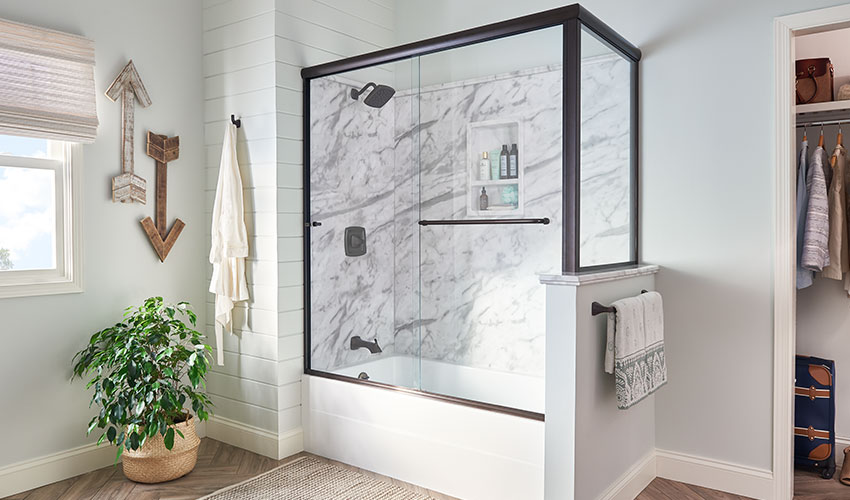Transitional Interior Design Ideas
Of all the decisions you’ll make throughout your bathroom remodeling process, one of the first and most important will be the design style you select. Regarding your options, there are four distinct design styles: contemporary, traditional, rustic and transitional.
Each style has its own unique characteristics. Deciding which you prefer can be tricky. [Read Uncover your design style in these 8 familiar places.] The beauty of the Transitional style is that it combines elements from opposing styles, so you have more freedom to choose pieces you like without worrying too much that they fall into the correct era. If you like elements from both traditional and contemporary styles, this might be the design for you. The key though, is in keeping the scale consistent so that one element or style doesn’t overpower the others. Think modern lines juxtaposed with vintage fixtures.
From flooring to wall tiles, furniture to fixtures, and even fabrics, there are dozens of choices you’ll need to make in order to pull off the look you want in your new bathroom. Let’s break down the elements of the transitional style.
Transitional Design Colors
Consistency is key when it comes to colors, but that doesn’t have to translate to boring. Neutral wall colors make a nice backdrop for the design elements in a transitional bathroom, but if you prefer dark and moody to light and airy, don’t be afraid to be dramatic. The trick with color in a transitional design is to stick to a single range of hues for consistency. Introduce four or five tones of the same shade, then add pops of color that draw the eye and add visual interest. Look for serene shades in blue, green or purple to keep the vibe calm and comfortable.
Transitional Design Surfaces
Flooring and countertops in transitional bathrooms tend to lean toward the traditional: marble and natural stone are both popular choices and work well with all aesthetics. What makes it transitional is its ability to blend with the other elements in the space. Transitional bathrooms can get away with almost any type of flooring. The style element comes into play in the pattern you choose. And while no patterns are strictly transitional, you can choose either a traditional flooring pattern, such as a classic marble checkerboard, or a vertical, straight stack subway tile for a contemporary vibe. If you opt for tile walls, choose timeless over trendy—a subway or marble tile pattern is perfect.
Transitional Design Furniture
The furniture in a transitional bathroom can lean either traditional or contemporary depending on what elements of the space you want you draw out. A traditional maple vanity with strong lines and elaborate detailing can be adorned with sleek, simple handles and pulls for a transitional twist. A mid-century modern floating sink pairs nicely with a classic marble countertop. Or opt for a round, wall-mounted sink in stainless steel or porcelain. Combining simple elements from both styles works beautifully when done well: Picture a set of antique apothecary jars resting on a vintage oak shelf near a modern, glass-walled walk-in shower.
Transitional Design Fixtures
Transitional design tends to be rather neutral, so the accessories you choose should pack a punch. The trick is to select fixtures that are bold enough to create visual interest without distracting from the overall aesthetic. Brushed nickel, steel, chrome, copper and lacquer are all great options for pulls, handles, faucets and light fixtures. Be consistent with metals—too many different styles will create chaos. A glass walk-in shower and DuraBath marble acrylic wall surround provide a contemporary focal point without overwhelming the space. Your goal with a transitional bathroom is to create effortless serenity and style.
Transitional Design Fabrics
A muted color scheme serves as the perfect palette for a traditional bathroom’s aesthetic features. Keep textiles limited to a range of three to four complementary shades. Fabrics are a place to get a bit playful—try combining different patterns for visual interest and depth without upsetting the balance you’ve worked to create. Here is another space where you can combine traditional elements, such as a nubby chenille bath mat, with their modern counterparts, a sleek leather stool, for example, to great effect.
Unique Transitional Home Design
As with any bathroom design style, the rules aren’t set in stone. That’s precisely the idea when it comes to transitional style; combine bronze fixtures with an antique vanity if that’s what feels good to you. Whether you want an era-bridging bathroom that’s both sleek and cozy, or another style altogether, Re-Bath can help. Schedule a free in-home design consultation today and start exploring your options.
Still having trouble choosing your favorite style? Take our design style quiz!
